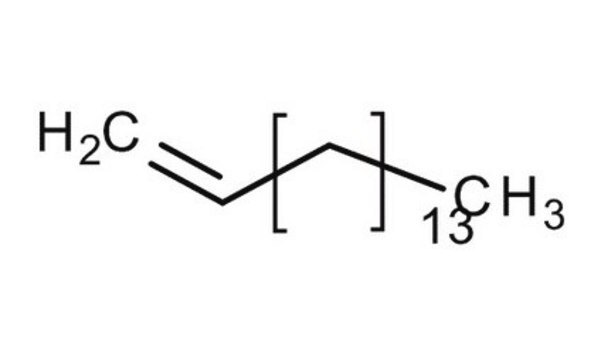H2131
1-Hexadecene
≥98.5%
Sinonimo/i:
Cetene
Autenticatiper visualizzare i prezzi riservati alla tua organizzazione & contrattuali
About This Item
Formula condensata:
CH3(CH2)13CH=CH2
Numero CAS:
Peso molecolare:
224.43
Beilstein:
1753401
Numero CE:
Numero MDL:
Codice UNSPSC:
12352100
ID PubChem:
NACRES:
NA.22
Prodotti consigliati
Densità del vapore
>0.8 (vs air)
Livello qualitativo
Tensione di vapore
<0.2 mmHg ( 20 °C)
Saggio
≥98.5%
Forma fisica
liquid
Temp. autoaccensione
464 °F
Indice di rifrazione
n20/D 1.441 (lit.)
P. eboll.
274 °C (lit.)
Punto di fusione
3-5 °C (lit.)
Densità
0.783 g/mL at 25 °C (lit.)
Stringa SMILE
CCCCCCCCCCCCCCC=C
InChI
1S/C16H32/c1-3-5-7-9-11-13-15-16-14-12-10-8-6-4-2/h3H,1,4-16H2,2H3
GQEZCXVZFLOKMC-UHFFFAOYSA-N
Cerchi prodotti simili? Visita Guida al confronto tra prodotti
Categorie correlate
Descrizione generale
1-Hexadecene, a long-chain alpha-olefin (LAO)containing 16 carbon atoms, commonly used as a precursor in the production ofsynthetic detergents, plasticizers, and various chemicals for the chemicalindustry. Additionally, it is a key component in commercial LAO blends,contributing to the manufacturing of tanning oils, synthetic fatty acids, anddrilling fluids.
Applicazioni
- Development of petroleum lubricating oil additives: A study evaluated newly synthesized copolymers and their montmorillonite nanocomposites as cold flow improvers for petroleum lubricating oils, including formulations with 1-Hexadecene, demonstrating enhanced flow properties (El-Bahnasawi et al., 2023).
- Attractants for biocontrol agents: Research identified volatile blends containing 1-Hexadecene that attract the biocontrol agent Galerucella placida, suggesting applications in agricultural pest management (Koner et al., 2022).
- Adsorbent materials for oil spill cleanup: A study explored the modification of commercial sponges with 1-Hexadecene-based polymers for efficient adsorption of crude oil and organic solvents, highlighting potential environmental cleanup applications (Jin et al., 2022).
- Surface engineering for hydrophobicity: 1-Hexadecene was used to create organosilane micropatterns on surfaces, improving their hydrophobic properties, relevant in material science and surface engineering (Soliman et al., 2021).
Avvertenze
Danger
Indicazioni di pericolo
Consigli di prudenza
Classi di pericolo
Asp. Tox. 1
Codice della classe di stoccaggio
10 - Combustible liquids
Classe di pericolosità dell'acqua (WGK)
WGK 1
Punto d’infiammabilità (°F)
269.6 °F - closed cup
Punto d’infiammabilità (°C)
132 °C - closed cup
Dispositivi di protezione individuale
Eyeshields, Gloves
Scegli una delle versioni più recenti:
Possiedi già questo prodotto?
I documenti relativi ai prodotti acquistati recentemente sono disponibili nell’Archivio dei documenti.
I clienti hanno visto anche
Yasuyuki Kubo et al.
mBio, 6(5), e01305-e01315 (2015-09-17)
The cucumber anthracnose fungus Colletotrichum orbiculare forms specialized cells called appressoria for host penetration. We identified a gene, FAM1, encoding a novel peroxin protein that is essential for peroxisome biogenesis and that associates with Woronin bodies (WBs), dense-core vesicles found
M Tobler et al.
Contact dermatitis, 26(5), 299-303 (1992-05-01)
In continuation of our preceding studies, we disclose long-term experiments to test more extensively the protective power of the novel 4H Glove. 2 compounds encountered in modern electron microscopy technique, 1-hexadecene (1-HD) and 2-hydroxyethyl acrylate (2-HEA), which elicit allergic and/or
Contact allergy to polyvinylpyrrolidone/hexadecene copolymer previously reported.
A C De Groot
American journal of contact dermatitis : official journal of the American Contact Dermatitis Society, 7(4), 260-260 (1996-12-01)
Paroma Mitra et al.
Pest management science, 77(1), 285-299 (2020-07-23)
The viviparous aphid Aphis craccivora Koch (Hemiptera: Aphididae) is a serious threat to the crop yield of Lathyrus sativus L. (Fabaceae), commonly known as grass pea. The synthetic insecticides applied to control this insect pest are not safe for the
C Barba et al.
Meat science, 90(3), 697-700 (2011-11-22)
Solid phase microextraction (SPME) coupled with either gas chromatography-ionization flame detector (CG-FID) or multidimensional gas chromatography-mass spectrometry (MDGC-MS) was evaluated for its ability to detect volatile hydrocarbons produced during the irradiation of cooked ham. The chromatogram of an irradiated sample
Il team dei nostri ricercatori vanta grande esperienza in tutte le aree della ricerca quali Life Science, scienza dei materiali, sintesi chimica, cromatografia, discipline analitiche, ecc..
Contatta l'Assistenza Tecnica.









